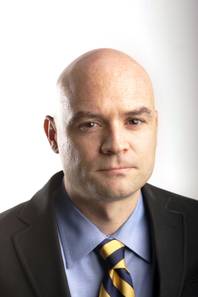
J. Patrick Coolican
Sun coverage
Reading accounts and watching the video of last week’s public fact-finding panel on the Metro shooting of Stanley Gibson was like being in a helicopter and hovering above an intersection — watching a brutal car accident while being helpless to do anything about it.
I’m not even talking about the actual shooting of Gibson, during which a botched plan to remove the unarmed, mentally ill Army veteran from a car wound up with him being shot seven times and killed by a Metro officer.
I was just as struck by the series of events in the 48 hours before the shooting, when Gibson, who was apparently experiencing a severe psychiatric episode, repeatedly came into contact with law enforcement and the health care system.
Flashing red lights should have prompted someone to secure his safety, and the safety of all of us, but the warning signals were unseen or perhaps ignored.
It reminds me of those government reports in the wake of the Sept. 11 terrorist attacks, when various agencies knew bits and pieces but no one put the whole puzzle together.
Let’s review what happened, as testified in detail last week by Metro Detective Clifford Mogg, the lead investigator of the incident.
On Dec. 10, 2011, police arrested Gibson — who had been diagnosed by the Department of Veteran Affairs with anxiety and depression and had been out of some medication and not taking others — after he lunged at an officer responding to a 911 call placed from his apartment, Entrata Di Paradiso, on North Rainbow Boulevard. Gibson was taken to the city jail, where the officers told the booking officer that Gibson needed to receive a psychiatric evaluation.
The nurse at the jail filled out a form, and under “Treatment plan” wrote, “Psychiatric evaluation.”
Except there was no psychiatric evaluation because he was released. Mogg explained that as part of a “depopulation program,” the detention center finds candidates to release on their own recognizance to relieve jail overcrowding, and Gibson fit the bill.
A Metro spokesman, citing ongoing litigation, said he could not comment.
After Gibson was released, he went to the Golden Nugget, where he grabbed some chips off a table and ordered to be dealt in. A Gaming Control officer was called. Gibson apparently had a rambling, nonsensical conversation with him. The officer cited Gibson for petty theft and released him.
The following morning, just after 8:30 a.m. Dec. 11, Gibson was wandering on foot in and out of traffic around Vegas Drive and Jones Boulevard.
An officer who responded had been one of the very same officers who had dealt with Gibson the night before.
Mogg said the officer “was surprised because it was his understanding, he told correctional officers that (Gibson) needed a psychiatric evaluation prior to being released.”
The officer determined that Gibson was “not lucid” and “not in touch with reality.” The officer began the process of what’s called a “Legal 2000,” in which someone who is a threat to himself or others can be detained.
“The officer felt Mr. Gibson was not of a mental status where he could adequately ensure his own safety and was actually a danger to himself,” Mogg reported.
Gibson was taken by ambulance to MountainView Hospital. Paramedics noted his history of anxiety, depression, suicide attempts and post traumatic stress.
He told paramedics he just wanted to get out of the cold and was not feeling suicidal.
He was admitted at 9:23. He briefly saw a physician, reported his history of mental illness and desire to get out of the cold and was released at 9:45, 22 minutes after admission.
A MountainView spokeswoman she said she could not provide any additional information. (Federal patient privacy laws continue after the patient’s death.)
According to Mogg, Gibson called 911 two more times that day, first complaining of chest pains and telling paramedics he was out of his anti-anxiety medication but then refusing service. After a second call in the early evening, he again declined treatment from paramedics, this time driving away in his own white Cadillac.
Gibson’s wife, Rondha, thinking Stanley had been taken by ambulance to University Medical Center, went there to find him. Not finding him there, she called Metro and reported her concerns about his erratic behavior. An officer spent time with Rondha Gibson. After consulting with a supervisor, he did not file a missing person’s report because Stanley Gibson had been calling Rondha that day (though always abruptly hanging up) and wasn’t considered a suicide threat or a threat to anyone else.
Here’s Mogg: “So at this point there was nothing put in to the Metro system that would flag Mr. Gibson or the Cadillac as being involved in these erratic acts that had occurred earlier in the afternoon.”
More 911 calls came — this time from residents in the Alondra Condominiums south of Gibson’s apartment. A caller reported a white Cadillac rammed its way through an emergency gate. Next, a woman reported an attempted burglary at her unit, with the suspect fleeing in a white Cadillac. Gibson was likely confused and lost.
As police responded to the burglary call, motorists were making 911 calls to report a white Cadillac driving east in the westbound lanes of Lake Mead Boulevard.
A short time later, the white Cadillac returned to the Alondra Condominiums. Patrol officers strategically blocked in the vehicle, and the rest is well known. Gibson wound up dead.
Of course, it’s easy to second-guess police and health care providers, who are already operating in the most challenging situation imaginable.
That’s not my intention.
But I think this story is worth our attention because it illustrates, with clarity, how broken our mental health care delivery system is.
It is underfunded and in disarray.



Join the Discussion:
Check this out for a full explanation of our conversion to the LiveFyre commenting system and instructions on how to sign up for an account.
Full comments policy